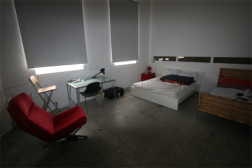Between Anxiety and Exhilaration
Post-residency Observations
Written by Chu Chu Yuan a.k.a. Zhu Ziyan
Chinese contemporary art has been the focus of global attention for a while now. And without a doubt, visitors to the Chinese art scenes in Shanghai and Beijing will feel the buzzing excitement, capped with the added element of the ‘exotic’ – a former communist nation with all kinds of repressed drives, now bursting in the seams, her people bending over their backs, performing Olympian feats trying to “outdo” others in the race of catching up with lost time and lost opportunities. There is a rich fermentation of the imagination and cross-fertilization of activities here. Art performances are directed as theatre productions, theatre incorporates installations, painters incorporate video strategies, video artists employ painterly effects, and fashion and packaging design gets into arts events and so forth.
Our 2 month residency in China, during which Jay Koh and I were attached with Bizart in Shanghai, gave us the time and opportunity to calm down and fathom the kinds of mental attitudes and energy that fuel the work of artists here. Being artists, researchers and art organizers ourselves, we were in China to research the contemporary art situation and we were also interested to find out what kind of synergies we would encounter in China among our peers and to see if there was any interest in the kind of work that Jay and I have been practicing, which performs social reflection and activism, not through confrontational strategies, but through participative public engagement, which we have termed “public engaged art.”
At the onset, one looks at the performances, installations, videos, sound, light, web art etc. that one often encounters in Chinese contemporary art and knows that contemporary art forms are now completely globalised. Yet one sees subtle to stark differences in the art historical developments of these art forms from country to country.
As we settled into our residency and began talking to artists and curators, the very distinctive character of Chinese contemporary history, as well as of contemporary art development in China, which no doubt has shaped the attitudes and kinds of art practices of today, began to unravel. The development of contemporary art in other Asian countries, such as Singapore, Thailand, Indonesia and Philippines, may offer some interesting counterpoints.
One very obvious reality of the Chinese contemporary scene is the market, and how readily it has absorbed experimental art forms. In the art historical development of most nations, time-based art, such as performances, video, audio, web and other ephemeral art forms, have been used to critique the market, to resist commodification and commercialization of art and ways of life. In Singapore for example, and similarly in many of the earlier ‘developed’ nations of Asia, artists from the late 70s to late 80s were using such art forms to critique the pervasiveness of capitalism, the market and the institution and began practising time-based art as anti-commercial work, using them as means to make social and political commentary.
However, in China, the strategy seems to be how to compliment the market, and not how to resist it. Perhaps this is due to the fact that market and political liberalization took place at the same time in China and perhaps because market liberalization brought about political liberalization. Since the demand of the market for Chinese art is so strong, performance, digital and other time-based artwork, are all produced incorporating strategies for marketing and sale. “Anything can be sold” must be the maxim. Actions are documented and packaged into series of large print photographs framed in light boxes. Ideas, actions and situations are dressed, styled and turned into ‘framable’ and ‘hangable’ objects.
So the social response and the market response seem to be simultaneously driving the critical as well as the creative imagination of the Chinese artist. Because of this, the market is embraced as a tool of empowerment, and the “carrier” of their ideas and messages. Critique and resistance of the market is not only absent, but artists think of strategies to “work up” and to “excite” the market.
However, slick and stylish presentation does not necessarily facilitate experience and enjoyment of a work. For example, the Shi Qing exhibition at Bizart in Oct 2006 was for me a show about ‘presentation’ and packaging. “This is how to present and package contemporary art” – big lavish photos on lightboxes, big screen videos, bright light sculptures. As I understand it, the fundamental idea for the artworks is all about ‘energy’ and basic energy exchange between persons, or a person within his/her environment. However, the ways the ideas were presented does not allow the viewer any intimate entry into the fluid states of being, as implied by the works and the performance of several ‘actors’ during the opening of the show.
While many critically-minded contemporary artists in Asian countries will still have hang-ups about using the market to convey their work, critically-minded contemporary artists in China just do not see this as a problem. It is a ‘clever’ and almost spontaneous act of playing to one’s advantage. And, in actual fact, a selling point of Chinese contemporary art is that it is “critical art”. The market just loves ‘criticality’.
And just how critical is Chinese contemporary art? While the market laps up “critical works of social and political commentary” from Chinese artists, most of the curators we spoke to are really skeptical that there is any really critical social or political artist in China. What does criticality involve? Does commercial success reduce one’s criticality?
For me, my interest was more to ask what the artists thought their own roles and positions are vis-à-vis their own society and culture. The by-now ‘conventional’ avant-garde strategy of confrontation and anti-sociality has found its way here, in the artists’ drive to find and uphold individualism. One recalls artist Xu Zhen’s (who is also artistic director of Bizart) print showing the knife-wielding artist standing alone facing an on-coming crowd.
There is a thick air of resistance or fankang worn by the artists, resistance towards local authority, resistance towards Western and foreign, towards being the voice of society, resistance towards responsibility (or rather prescribed responsibility), towards any prescribed role of an artist.
Fankang seems to be the rallying cry – but what then do they stand up or fight for? The only answer I heard is ‘individuality.’ This is of course understandable in the context of Chinese history. Can the contemporary Chinese artist really be an individual in his/her society? (One begins to think of all the Fang Li Jun painting look-a-likes). Individuality is not synonymous with independence of course. Someone once told me that in China, life is about drawing circles, everything and everyone is inter-related. What holds up the artist’s position in society? What holds up his/her value in the system that validates him/her? Even as they are resisting “foreignness”, what is foreign to them?? And what is Chinese? It is a known fact that it is foreign patronage that holds up the market value of Chinese artworks.
Of course, one can understand these efforts as a drive towards molding the individual persona.
In situations of distrust of state propaganda and resistance towards imposed morals and regulations, people strive to set their own personal standards of judgment. In China, there is a strong tradition of declaring public judgment of right and wrong, of moralizing. However, although the artists look like they are somehow rebelling against this, sometimes their methods, because of their extreme “anti-sociality”, can border on a kind of didacticism.
This points to an inherent and difficult contradiction to avoid in making critical art, that one often reinforces the social ills or problems that one criticizes.
And does legitimacy or the power of critique depend on one’s ethical position? What gives the artist and art the power of critique? How does society view artists’ role in offering this critique? Is it just a ‘performance’ or a ‘posturing’ for the western curator, buyer, and exhibition organizers? Is the (ethical) position of the artist an empty one?
The validity of such art lies in the fact that it has legitimacy to critique the ills of society. In western art historical development, art has occupied a privileged position. Institutions and the market continue to safeguard this privileged position of art and artists for different reasons. However, today, many art practitioners are beginning to question the privileged position of art and the artists.
But when one tries to engage the artists in a critical discourse on these issues, not many artists seem to be interested to answer such questions, especially so in China. How is it that critical artists do not welcome critique or critical discourse? We are told that if a critic questions a show and asks critical questions about it, very soon, someone will begin to whisper into the ear of the critic: How has the artist offended you?
Perhaps this dislike of critical discourse, of pinning down one’s position is due to a desired ambiguity, which allows easy maneuvering, in a system that does not empower the individual. And “double-facedness” has for a long time been a very useful and necessary strategy for survival in China and many other cultures with history of repression.
Additionally things are always changing so fast in China, one may not be able to stop long enough at one place to have a position to begin with. And if one is practically-minded about it, it is a completely useless thing to have. However, do these questions go away just because one does not want to, or does not have the time to acknowledge or confront them?
The dizzying speed of change, which robs the artists of the time to dialogue, also seems to rob them of the time to explore process in one’s work. Of course, if one steps back to look at the situation, one can look at this whole phase of Chinese contemporary art production itself as a process – a process of reacting to head-spinning effects of the market, a process of trying to find one’s balance.
The speed also seems to be robbing them of time to rest. Hot-selling artist Shi Yong, famous for the blonde-wig-wearing archetypal Chinese consumer character that appears in his art, exasperatedly declares: “I cannot afford to rest. I can’t afford to look away. If I take a break, I’m afraid I’ll be left behind. Everyone and everything will have gone ahead of me and have forgotten me.” As we parted ways from a rather lengthy afternoon tea-drinking session, he said “Hey, good luck finding interest for your public engaged art project” half-concealing a “sorry for these folk” look.
Xu Zhen echoes this sentiment: “Chinese artists are too busy catching up with what’s happening inside China, there is no time to dialogue with outside.” His artwork of a clock that is set faster than normal, installed on top of the Shanghai Art Museum building during one of the art biennials, illustrates this.
However, Chinese artists do not seem to feel any lack from this. They are too preoccupied with all the attention they are getting – the world’s eyes are on them. They do not have enough time to make enough art to meet the demands, so how can they find time to dialogue?
But surely this does not apply to all artists. There must be artists who feel discontented with the current situation, and feel a need to critically reflect and dialogue? One artist who reflected this is Qiu Anxiong. Qiu is a quiet and contemplative artist based in Shanghai. He creates, among other works, animated videos using Chinese traditional cartoon figures. Spending 2 years in discourse-loving Germany may have influenced his attitudes and outlook and gave him the sense of a need to build a theory, process and methodology to his work.
On the whole, my conversations with many Chinese artists gave me the impression that they are living and working in a void where nothing is defined, fixed, trustworthy or dependable. A space charged with possibilities and anxieties – at the same time terrifying and exhilarating.
I asked a hopeless question: “What is Chinese contemporary culture to you?”
Xu Zhen’s offering:
“At this moment it is not possible for us to imagine what is (contemporary) Chinese culture. Maybe if everyone now begin to set and use their own standards to do things – then together that can become a ‘common’ denominator’, a common culture. If all artists are given the possibility to do exactly that which they want to do, then slowly, we will begin to see a contemporary culture emerging.”
And oh yes, the answer to our public engaged art invitation? Not yet, no thank you.
P/S. I have written the above as an attempt to portray the attitudes of the 20 or so Chinese artists we managed to speak to, and the environment that they work in. This is independent of my evaluation of their artworks. And I do think that it is possible to make powerful art without theory or discourse.
Chu Yuan is a visual artist who also organizes and researches. She began her art practice in Singapore in the early 90s. She ran the 1948 Artspace in Seri Kembangan, on the outskirts of Kuala Lumpur, Malaysia until beginning 2009.


